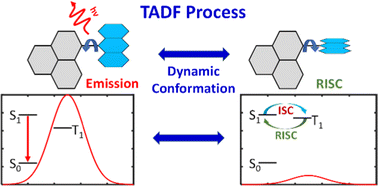Interplay of molecular dynamics and radiative decay of a TADF emitter in a glass-forming liquid†
Abstract
We investigate the role of molecular dynamics in the luminescent properties of a prototypical thermally activated delayed fluorescence (TADF) emitter, NAI-DMAC, in solution using a combination of temperature dependent time-resolved photoluminescence and absorption spectroscopies. We use a glass forming liquid, 2-methylfuran, to introduce an abrupt change in the temperature dependent diffusion dynamics of the solvent and examine the influence this has on the emission intensity of NAI-DMAC molecules. Comparison of experiment with first principles molecular dynamics simulations reveals that the emission intensity of NAI-DMAC molecules follows the temperature-dependent self-diffusion dynamics of the solvent. A marked reduction of emission intensity is observed as the temperature decreases toward the glass transition because the rate at which NAI-DMAC molecules can access emissive molecular conformations is greatly reduced. Below the glass transition, the diffusion dynamics of the solvent changes more slowly with temperature, which causes the emission intensity to decrease more slowly as well. The combination of experiment and computation suggests a pathway by which TADF emitters may transiently access a distribution of conformational states and avoid the need for an average conformation that strikes a balance between lower singlet–triplet energy splittings versus higher emission probabilities.



 Please wait while we load your content...
Please wait while we load your content...
